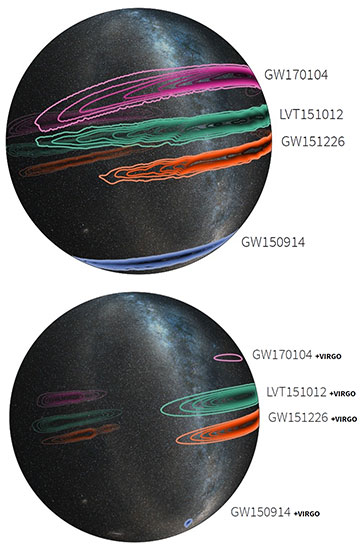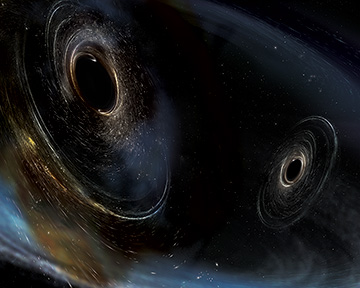The gravitational-wave signal in the most recent LIGO observation suggests that it came from the merger of two black holes spinning at different orientations. [Image: LIGO/Caltech/MIT/Sonoma State (Aurore Simonnet)] [Enlarge image]
The consortium running the Advanced Laser Interferometer Gravitational-Wave Observatory (LIGO) has announced that the giant device has detected a third event, picking up ripples in spacetime from a binary black-hole merger nearly 3 billion light-years away. That’s a distance more than twice as great as in the initial LIGO observation announced in February 2016. The observation has allowed the consortium scientists to put new constraints on models of how black-hole pairs evolve, and to log some additional tests of general relativity (Phys. Rev. Lett., doi: 10.1103/PhysRevLett.118.221101).
The detection of an event at this vast distance grew out of additional improvements to Advanced LIGO’s engineered sensitivity, stemming from upgrades after the instrument’s first observational run. And, according to the team, as future upgrades push the instrument toward its ultimate design sensitivity, the detection of binary black-hole mergers could become literally a daily event.
Those sensitivity increases—coupled with the future on-streaming of additional gravitational-wave observatories such as the European Advanced Virgo facility and LIGO India—will move the world closer to an era of what David Shoemaker, the spokesperson for the LIGO Scientific Collaboration, calls “multi-messenger astronomy.” Such an astronomy would combine gravitational-wave observations with electromagnetic-wave observations, such as those from traditional optical telescopes, to allow new insights in astrophysics and cosmology. “We’re moving from novelty to a new observational science,” Shoemaker said in a press conference. “A new astronomy of gravitational waves.”
Growing population
The observation itself, detected by the twin LIGO interferometers at Hanford, Wash., and Livingston, La., USA, occurred on 4 January 2017. Since then, members of the LIGO Scientific Collaboration—including more than a thousand scientists involved with LIGO and with the European Virgo project, still under construction—have been picking apart the waveforms sensed by LIGO to see what it found.
The LIGO team notes that the instrument’s observations suggest a “new population of black holes” with masses larger than what had been seen before with X-ray studies alone. [Image: LIGO/Caltech/MIT/Sonoma State (Aurore Simonnet)] [Enlarge image]
In this case, the modeling indicates that the detected waves came from the catastrophic merger of two black holes, with a total mass approximately 49 times that of the sun, at a distance from Earth of some 880 megaparsecs (2.87 billion light years, or a redshift of approximately z = 0.18). The mass of the newly detected merger lies between those of the previous two black-hole mergers detected by LIGO. The team views the observation as confirmation of a presumably large population of black holes above 20 solar masses in size—objects, according to Shoemaker, that “we didn’t know existed before LIGO detected them.”
Tilted merger
Interestingly, the observations in this case also indicated that the black-hole spins around their axes may have been tilted with respect to one another, rather than being aligned. LIGO scientist Laura Cadonati, with the Georgia Institute of Technology, said the situation was analogous to “two tornadoes going around each other.” She noted that in mergers in which spins of those black-hole tornadoes are aligned, the two objects need to shed some of their rotational energy before they can coalesce into a single black hole. That leads, she said, to a delay known as the “hangup effect” that can be seen in the gravitational waveform.
The modeling of the waveforms detected in the recent LIGO observation, said Cadonati, “disfavor” such an effect, and indicate that the spins of the two black holes were more likely tilted with respect to their orbits around one another. That’s important, she notes, because it “slightly favors” the possibility that the black holes formed separately and merged later in life in crowded stellar clusters, rather than representing the merger of black holes that got their start from the collapse of two stars already linked in a binary star system.
More kudos for Einstein
The increased observational distances afforded by the upgraded LIGO also allowed the researchers to squeeze in a few additional tests of Einstein’s theory of general relativity—which once again passed with flying colors. The observed merger is far enough away, noted Bangalore Sathyaprakash of Penn State University, USA, that “we can now ask whether gravitational waves lose energy” through dispersion as they travel through vast distances. General relativity holds that gravitational waves should be nondispersive—and, indeed, an analysis of the waveform from the newly discovered black-hole merger at different frequencies found no evidence of dispersion, another indication that Einstein had it right.
Further, the LIGO–Virgo team was able, through the new observation, to put tighter constraints on the mass of the graviton, the hypothesized particle that supposedly mediates the gravitational force (analogous to the way that the photon, for example, mediates electromagnetic force). General relativity holds that gravitons should be massless. While the consortium scientists couldn’t quite establish that, they did manage to constrain the mass of gravitons, if they exist, to less than 7.7 × 10–23 eV/c2—about 30 percent tighter than previous constraints, according to Sathyaprakash.
Ever-improving sensitivity
The new observation grew out of improvements to LIGO’s engineering sensitivity after its last observational run, which concluded in January 2016. Those improvements, said Michael Landry, the lead scientist at LIGO’s Hanford facility, included efforts to eliminate scattered light, and thus reduce noise, in the detectors at the Livingston interferometer. At Hanford, meanwhile, the improvements focused on increasing laser power (and on counteracting the side-effects of that power increase, such as heating of the instrument’s mirrors). In the wake of the those improvements, the second observation run for LIGO began on 30 November 2016—with the newly announced discovery coming just over one month later.
The current observing run at LIGO will continue for another few months, until August, according to Landry. At that point, the instrument will undergo another round of sensitivity upgrades, including the swapping out of some mirrors for even more refined versions; additional improvements to laser power; and further efforts at noise reduction and improved computer control. Those sensitivity improvements, said Landry, will extend still further the reach of the LIGO instrument into space; he pointed out that every twofold reduction in LIGO’s noise means an eightfold increase in the volume of space that the instrument can query.
According to Sathyaprakash, the calculations available from the observations thus far suggest that, once LIGO reaches its ultimate design sensitivity, “we should expect to see one binary black-hole merger per day.” Further, the LIGO team hopes that the better sensitivity will open up the observational menu well beyond the sphere of black-hole mergers, to include events such as the merger of binary neutron stars. Those events, Landry noted, should provide new insights into “the extreme states of nuclear matter.”

The LIGO-Virgo consortium believes that the addition of the Virgo instrument, slated to come online this summer, could substantially improve the ability to localize gravitational-wave sources in space. The top diagram shows the uncertainty in location from the LIGO observations alone (including one low-statistical-significance observation, LVT151012); the bottom diagram shows the uncertainty when hypothetical data from Virgo are added. [Image: LIGO/Caltech/MIT/Leo Singer; Milky Way image: Axel Mellinger]
Pinning down the source
Crucial to gleaning those insights will be combining the gravitational-wave observations with others from the electromagnetic spectrum—that is, from traditional telescopes and space-based gamma-ray observatories. One current problem in making those ties, the scientists noted, is that, while LIGO is able to reach increasingly far into space to suss out gravitational waves, it currently has very little information on just where in the sky those waves are coming from. That makes it tough to tie a given LIGO detection event to the pinpoint observations of traditional telescopes.
The addition of the Virgo instrument, expected to go online in August, could considerably sharpen that view—allowing, according to Cadonati, a one- to two-order-of-magnitude accuracy gain in localizing gravitational-wave sources in the sky. That should offer a better shot at tying these events to observations with more traditional astronomical instruments. Virgo’s debut will also add a different instrument orientation to the mix, which could enable new information on the polarization of gravitational waves.
Virgo will be only the first of a series of additional, post-LIGO observatories coming on line in the future. Another will be LIGO India, a collaboration with Indian scientists to create a third point in the LIGO system, currently planned to commence operation in 2024. Still another instrument, in Japan, will come on line in “a gradual way,” said Shoemaker, over the same time frame.
“I think what we can say,” he concluded, “is that by the mid-2020s, we will have quite a network of detectors.” And that network, he suggested, should improve uptime and localization—helping to make routine multi-messenger astrophysics a tangible reality.


